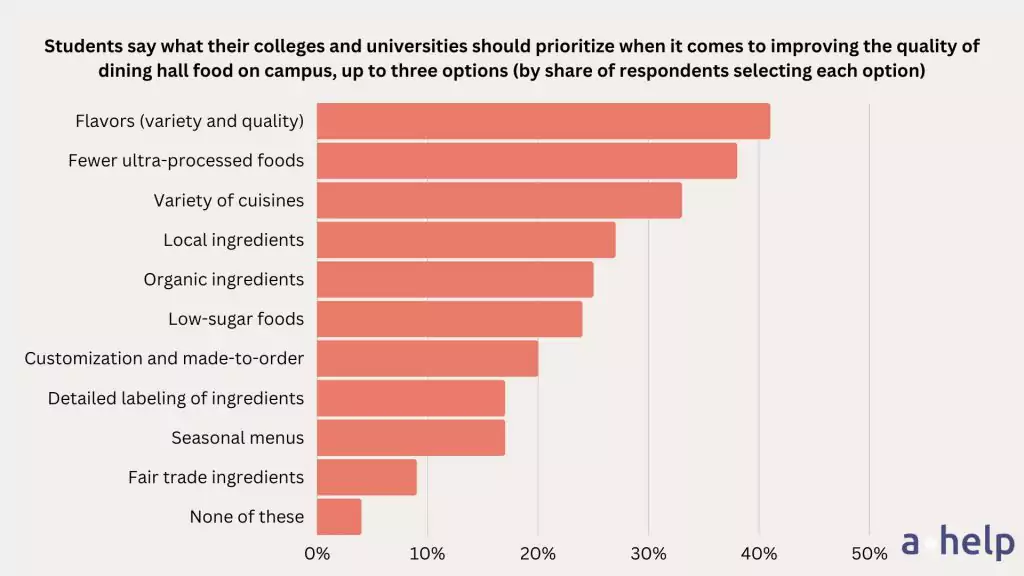The health and wellness of students on college campuses are drawing more attention than ever before. A recent survey uncovered the preferred wellness activities and food choices among college students, highlighting opportunities for improvement in campus dining and wellness programs.

✅ AI Essay Writer ✅ AI Detector ✅ Plagchecker ✅ Paraphraser
✅ Summarizer ✅ Citation Generator
Key Takeaways:
- Physical activity improves students’ physical and mental health, boosting academic performance and social integration.
- Students demand healthier, diverse, affordable, and accessible campus dining options with detailed food labeling.
- Timing and location of wellness activities pose significant accessibility issues, requiring institutions to align these services with student schedules and needs.
How Physical Activity Benefits Students
Physical activity plays a significant role in the overall well-being of students. Not only does it help them maintain a healthy body, but it also significantly contributes to their mental health.
Engaging in regular physical activity, such as going to the gym, taking part in recreational sports, or even simple group walks or hikes, can reduce stress, improve concentration, and promote better sleep. As Jack Donovan, president of Aramark’s collegiate hospitality division, highlights, a stable and socially connected lifestyle is key to student wellness. Physical activities provide an excellent platform for students to interact, creating a sense of community and belonging. It becomes their “home away from home”, which in turn improves their academic performance and overall college experience.
By participating in physical activities, students can find their unique ‘touchstone’ amidst the pressures of college life, leading to a balanced and healthier lifestyle.
According to the Student Voice survey, students value their gym time above all other wellness activities. However, a common concern among students is the lack of flexible gym hours that align with their schedules.
“The majority of students would use more campus wellness resources if the timings suited their schedules better.”
Campus Dining
The survey also shed light on student’s preferences regarding on-campus food. A little over half of the respondents said they had enough access to campus dining halls. Yet, only a quarter felt that their colleges were providing satisfactory dining hall options. Merely 15% were happy with their campus’s wellness class selection.
Students yearn for healthier, high-quality food and demand better access to it. As J. Donovan puts it:
“The ideal student dining experience is about social connection and stability. Students’ needs and tastes can change daily but, they seek food experiences that are either highly efficient or highly experiential”
When it comes to improving campus dining, students listed variety and quality of flavors as the top priority. They also prefer fewer ultra-processed foods, various cuisines, and local and organic ingredients. Detailed labeling of ingredients, customizable meals, and seasonal menus were also desired features.

One key aspect that colleges and universities should prioritize, according to almost half of the students, is affordability. They also emphasize the importance of dining halls being open early mornings, late nights, and continuously throughout the day.
Students also expressed a wish for more accessible food services, the ability to use dining points or dollars across the campus, and detailed labeling of ingredients to assist with dietary restrictions. Elizabeth Riede, executive director of campus dining at Appalachian State University, says:
“We are first and foremost in the customer service business. We see ourselves as an integral part of students’ college experience.”
Preferred Wellness Activities and Barriers to Access
Apart from going to the gym, students also enjoy group walks or hikes, exercise classes, recreational sports, yoga classes, and cooking workshops. They also showed a liking for therapy dog events, art therapy classes, mindfulness and meditation workshops, and stress management workshops.

However, one of the major factors preventing students from accessing wellness facilities is the timing. Four out of ten students choose hours that fit their schedules as the main barrier. Proximity was another factor, cited by 31% of the respondents.
Jennifer Knerr, assistant director of the Wellness Center at the University of Wyoming, summarizes their approach to these challenges:
“We want to have something for everyone. We want to be a place for everyone. And so we do try to offer that wide variety of programming.”
The survey results highlight a significant opportunity for colleges and universities to improve their wellness programs and campus dining options. By aligning with students’ needs and priorities, institutions can not only boost satisfaction but also contribute positively to student success.
Follow us on Reddit for more insights and updates.





Comments (0)
Welcome to A*Help comments!
We’re all about debate and discussion at A*Help.
We value the diverse opinions of users, so you may find points of view that you don’t agree with. And that’s cool. However, there are certain things we’re not OK with: attempts to manipulate our data in any way, for example, or the posting of discriminative, offensive, hateful, or disparaging material.